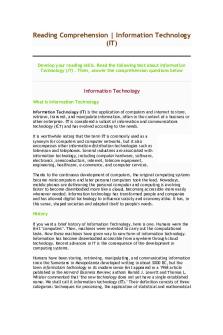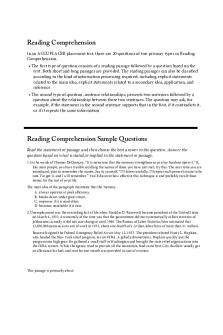Reading Comprehension 12 PDF

| Title | Reading Comprehension 12 |
|---|---|
| Course | Sociology Of The Family |
| Institution | Brigham Young University-Idaho |
| Pages | 2 |
| File Size | 55.3 KB |
| File Type | |
| Total Downloads | 82 |
| Total Views | 209 |
Summary
This is a weekly assignment to summarize the readings for the week and answer two questions regarding the important topics. This is for week 12....
Description
Reading Comprehension Part A
In the article, “Life Without Father: What Happens to the Children?” by McLanahan & Schwartz, statistics regarding children without fathers are shared. These statistics are very surprising. They stated that over half of Americans will live without the presence of both parents in the home before the age of adulthood. And over 1/5 of these people will have never lived with the father. This is an astonishing statistic. The authors of the article then elaborate on the effects that this can have on children. They share that girls are more likely to have trust issues in their future relationships if they didn’t grow up with a father in the home. They are also more likely to become pregnant out of marriage. The boys who grow up with only a single parent in the home are less likely to keep a job for a long period of time and have successful marriages. As for both genders, it is less common for kids without both parents in the home to finish schooling, obtain college degrees, and become employed. The second article entitled, “Children’s Adjustment Following Divorce: Risk and Resilience Perspectives” by Kelly and Emery discusses the blame that parental divorce can carry for the range of serious behavioral actions and mental health issues that children are being faced with. This article talks about what happens to a child mentally, socially, and emotionally after a divorce of their parents. Divorce in homes affects children as they feel betrayed and develop habits of mistrust for their parents.
Part B 1. What are the three main problems that father absence following divorce causes for children, and why are they problematic for children? 1. Economic deprivation- As fathers don’t always continue to support the families, the family may fall into poverty. Single mothers more often than not have to work outside the home, causing there to be a lack of motherly responsibilities being performed in the home, which is damaging to children. 2. Poor parenting- Divorced parents will often times talk bad about the other parent who isn’t present, which turns the child against their own mother or father. The parent who is present in the home typically acts more as a friend to their child rather than a parent in attempts to keep a relationship with them. Single parents are also more likely to lean on their children for support, which is not healthy for their parent/child relationship. 3. Lack of social support- There is a lack of social support for single parents and broken families. These children who do not have both parents in the home are seen as the minority and they are less involved in schools and extracurricular activities and sports.
2. What are three important protective factors that may help reduce the effects of parental divorce on children? 1. Parents should be informed about the serious consequences that derive from father’s absence in the home. Although this won’t always prevent actions in this regard, parents can be more aware of ways to minimize the affects that will hit their children. 2. We can also work as a society to promote marriage rather than demote it. Marriages should be seen as happy and successful and a way of life that everyone should experience. By including “marriage penalties” in our taxes, that is not a way to promote marriage and does a great job discouraging it among individuals. 3. Lastly, it is important that fathers are not only paying child support funds for their children and mothers, but that they are still present (if safe) in the children’s lives. If relations with their father aren’t completely cut off, children will feel more accepted and involved....
Similar Free PDFs

Reading Comprehension 12
- 2 Pages

READING COMPREHENSION
- 1 Pages

Activity 11 Reading comprehension
- 10 Pages

Elc reading comprehension task
- 11 Pages

501 READING COMPREHENSION QUESTIONS
- 169 Pages

Reading Comprehension IT
- 2 Pages

Reading Comprehension Computers
- 1 Pages

Set 1 Reading Comprehension
- 108 Pages
Popular Institutions
- Tinajero National High School - Annex
- Politeknik Caltex Riau
- Yokohama City University
- SGT University
- University of Al-Qadisiyah
- Divine Word College of Vigan
- Techniek College Rotterdam
- Universidade de Santiago
- Universiti Teknologi MARA Cawangan Johor Kampus Pasir Gudang
- Poltekkes Kemenkes Yogyakarta
- Baguio City National High School
- Colegio san marcos
- preparatoria uno
- Centro de Bachillerato Tecnológico Industrial y de Servicios No. 107
- Dalian Maritime University
- Quang Trung Secondary School
- Colegio Tecnológico en Informática
- Corporación Regional de Educación Superior
- Grupo CEDVA
- Dar Al Uloom University
- Centro de Estudios Preuniversitarios de la Universidad Nacional de Ingeniería
- 上智大学
- Aakash International School, Nuna Majara
- San Felipe Neri Catholic School
- Kang Chiao International School - New Taipei City
- Misamis Occidental National High School
- Institución Educativa Escuela Normal Juan Ladrilleros
- Kolehiyo ng Pantukan
- Batanes State College
- Instituto Continental
- Sekolah Menengah Kejuruan Kesehatan Kaltara (Tarakan)
- Colegio de La Inmaculada Concepcion - Cebu







